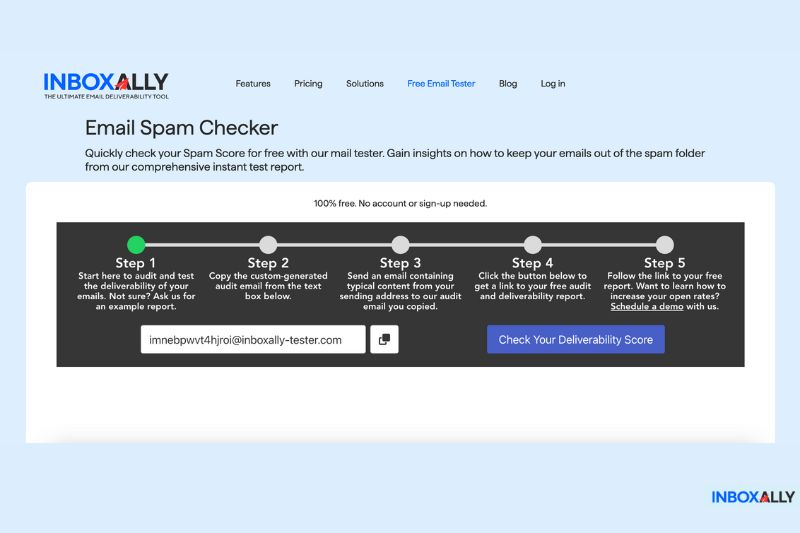Mailchimp is a go-to for email marketing, but if your emails keep ending up in spam, it’s more than just an annoyance—it’s a problem that ruins engagement and hurts your sender reputation. And no, it’s not always about spammy content. Email filters are picky, and Mailchimp’s setup doesn’t always work in your favor.
If you’ve been asking, “Why are my Mailchimp emails going to spam?” you’re in the right place. From authentication issues to Mailchimp’s shared sending domains, we’re breaking down exactly what’s happening—and more importantly, how to fix it.
Let’s get into it.
Why are My Mailchimp Emails Going to Spam?
![]()
Many Mailchimp users also struggle with emails going to spam in Gmail due to Gmail’s stringent filtering rules, making authentication and sender reputation even more crucial.
If your emails keep landing in spam, you’re not alone. Email filters are stricter than ever and a few mistakes—whether technical or content-related—can lead to deliverability problems. So here’s what might be working against you and how to fix it:
1. Your SPF and DKIM Records Are Not Properly Configured
Spam filters may flag your Mailchimp emails because your Sender Policy Framework (SPF) and DomainKeys Identified Mail (DKIM) records are not properly configured.
In simple terms, SPF allows senders to specify which IP addresses are authorized to send emails on behalf of their domain, while DKIM ensures that messages are authenticated with a digital signature, preventing tampering or forgery.
Both are important email authentication protocols that confirm your emails are legitimate. Without SPF and DKIM, email servers may see your messages as suspicious or fraudulent, increasing the likelihood of them being flagged as spam.
Read more about SPF, DKIM & DMARC here
2. Your Domain Reputation Is Poor
Domain reputation is one of the most important factors in email deliverability. Think of it like a personal reputation—it’s influenced by your history, associations, and actions.
If your domain has a track record of sending spam or low engagement rates, inbox providers may flag it as untrustworthy, pushing your emails into spam instead of the inbox. Other contributing factors include spam complaints and high bounce rates.
Maintaining a strong domain reputation requires consistent monitoring and good email practices, such as sending relevant content and keeping your email list clean.
Did you know that there are tools specifically designed to address this problem? InboxAlly’s advanced seed email system and authentic user interactions help improve your sender reputation and boost engagement. Start improving your email performance today.
3. You’re Using Spam Trigger Words in Your Emails
When your email content contains spam trigger words, there’s a high chance it won’t reach your target audience’s inboxes.
This happens when your subject line or email body contains terms that sound pushy, manipulative, or overly salesy, triggering spam filters. Words that evoke urgency, exaggeration, or deception can raise red flags for inbox providers.
A few common spam trigger words include:
- Act Now
- Call Now
- 100%
- All-New
- Bonus
- Prize
- Will not believe your eyes
While no single word guarantees a trip to the spam folder, using too many of these together can make your emails look suspicious. Keeping your language natural and focused on value is a better way to get past filters.
4. Errors in Grammar and Spelling
This may not seem like a big deal, but having a poorly written email is another reason your Mailchimp emails end up in spam.
Scammers often don’t bother with proper grammar and spelling when sending phishing emails. While spam filters are getting smarter, this association still exists, which makes well-written, polished email copy even more important
Beyond focusing on clean, professional design, be sure to avoid:
- Flashy color and big fonts
- A lot of “$” signs and exclamations (!!!!!!), and
- Too many images
Sloppy writing hurts readability and makes your emails look untrustworthy. Professional copy, on the other hand, signals legitimacy and keeps your audience engaged. A little polish goes a long way!
5. Your Email Engagement Is Low
Once you’ve crafted good content, perfected your email design, and hit “send,” tracking your email engagement is essential.
Email marketing engagement measures how recipients interact with your emails. Did they open it? Did they read the content? Did they click on your links or follow your call to action?
If most users ignore your emails, inbox providers take that as a sign that your messages aren’t valuable and may start filtering them into spam. Even worse, if enough people report you for spam, it signals that your emails are unwanted, damaging your sender reputation and making inbox placement even harder.
How to Prevent Mailchimp Emails From Landing in Spam
Now that you know why your Mailchimp emails end up in spam, here are some quick solutions to improve deliverability:
Check Your Campaign Content
Before you send your next email, use this quick checklist to avoid spam filters.
- Have you authenticated your domain? Check your SPF, DKIM, and DMARC records in your domain settings. If not set up, follow this guide to authenticate.
- Are you using a dedicated sending domain (not Mailchimp’s shared domain)? A custom domain boosts deliverability. If you’re using “mailchimpapp.net,” consider switching to a private domain.
- Did you check your email’s spam score? Use InboxAlly’s email spam checker to analyze your email’s spam risk.
- Are you avoiding spam trigger words in your subject line and content? Refrain from using “FREE,” “Act Now,” “Limited Offer,” and other high-risk words.
- Is your HTML code clean and error-free? Messy HTML triggers spam filters!
- Are your email images and text balanced? Maintain a 60:40 text-to-image ratio to prevent spam flagging.
- Have you tested email deliverability with a seed email list? Send test emails to multiple inbox providers (Gmail, Yahoo, Outlook) to check placement.
- Did you remove inactive subscribers and verify email addresses?
If you’ve checked all the boxes, you’re all set!
Sending bulk emails efficiently while maintaining high deliverability can be challenging. If you want to ensure your emails reach inboxes, check out this guide on how to send bulk email without spamming for proven strategies to improve your email marketing success.
Use Double Opt-In
A double opt-in list (DOI) means that once they sign up, users receive an email with a link to confirm their subscription.
Although this method may result in slower list growth compared to a single opt-in, it keeps higher-quality subscribers who genuinely want to receive your emails. This gives you better engagement, fewer spam complaints, and improved inbox placement—all of which help with your email deliverability in the long run.
Recheck Your SPF/DKIM Records
As mentioned earlier, SPF and DKIM records are essential for email authentication. You can log into Mailchimp to check and verify your settings.
While most users configure these records initially, later DNS changes or updates can unintentionally disrupt SPF and DKIM settings. It’s always wise to do some double-checking.
Test Your Email Spam Score
To prevent your Mailchimp campaigns from going to the spam folder, test the “spammy-ness” of your email first before sending.
You can use our free email spam checker for a free audit and to calculate your spam score.
The closer you get to a perfect score of 10, the better your chances of reaching inboxes. Pay attention to the tool’s suggestions to improve your email’s performance.
Consider running an inbox placement test to see exactly where your emails end up—whether in the primary inbox, promotions tab, or spam folder. This insight lets you adjust your strategy for even better deliverability.
Maintain a Healthy Email List
Another way to improve the deliverability of your Mailchimp campaigns is to keep your audience clean and engaged. Regularly go through your list and remove inactive email addresses that no longer engage with your emails.
Remember, ESPs take spam complaints seriously and may block you if you’re repeatedly sending emails to recipients who haven’t given proper permission.
Check Blacklist Databases
By identifying if your domain or IP address is blacklisted, you can take early corrective actions to resolve issues before they impact your email campaigns. This proactive approach helps prevent your emails from landing in spam, ensuring they reach your subscribers’ inboxes.
A common warning sign of blacklisting is receiving a 550 high probability of spam error, indicating that your messages are being rejected due to suspected spam activity or poor sender reputation.
Strict filtering policies can prevent emails from reaching inboxes. Issues like Yahoo blocking emails often stem from poor domain reputation or misconfigured authentication records. Ensuring proper setup improves deliverability
Monitoring these databases on platforms like MXToolbox also provides insights into the reasons for blacklisting, allowing you to address underlying problems such as high spam complaints or sending to invalid email addresses. Overall, staying vigilant with spam database checks enhances your email marketing effectiveness and keeps your email list clean and engaged.
Use merge-tags
An audience field with a merge tag, which is a unique identifier, stores the data you import into Mailchimp. This provides extra information about the subscriber, enhancing personalization and targeting, regardless of whether they have a Mailchimp account.
Using merge tags can help you avoid ending up in the junk folder by making your emails more personalized and relevant to each subscriber
Personalized emails are more likely to be opened and engaged with, sending positive signals to email providers that your content is valuable and desired. This improved engagement reduces the likelihood of your emails being marked as spam.
Treat Emails as an Extension of Your Brand
Think of your email marketing campaign as an opportunity to promote your brand identity.
Your clients already recognize your design features, graphics, and content style, so maintaining consistency helps reinforce your brand identity. Straying too far from your established brand elements may confuse recipients and risk your emails being marked as spam, impacting your domain’s acceptance factor.
If you need some real-life inspiration and guides to market your small business using Mailchimp, check out this link for films, podcasts, and original series celebrating the entrepreneurial spirit!
Final Thoughts
We hope you find these tips helpful. One important note to remember: whether you’re sending through Mailchimp or other email platforms, the key to success is to keep your target audience at the core of all your email marketing efforts.
Ultimately, your marketing campaigns should be about your business and what’s in it for your audience.
And if email deliverability is holding you back, it might be time for a real solution. InboxAlly helps you build a stronger sender reputation, boost engagement, and keep your emails out of spam. With advanced inbox placement tools and real user interactions, you’ll see better results faster. Get started with InboxAlly today.



